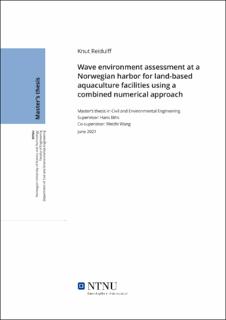Sammendrag
Numerical wave modeling of Norwegian coastal areas is challenging due to the strongly varying bathymetry, irregular coastline, and large domains of interest. Phase-averaged models provide an appealing solution due to their computational efficiency, but have limitations in areas of strongly varying bathymetry and irregular coastline. Phase-resolved models provide higher accuracy with the trade-off of significantly higher computational cost. The goal of the study is to provide an open-source combined modeling approach to harbor design and use the approach to analyze the the wave conditions at two proposed locations for on-shore aquaculture facilities at Fiskenes and Breivik, Andøya.
The numerical wave models chosen for this thesis is the phase-averaged model SWAN and the phase-resolved model REEF3D::FNPF. The analysis will be performed in three model steps, with increasing accuracy closer to the proposed locations of Fiskenes and Breivik. The phase-averaged analysis in SWAN will employ a nested approach between simulation steps, and an interpolation scheme is used to obtain more information about possible met-ocean conditions without requiring additional simulations. A unidirectional spectrum extracted from the SWAN simulation will serve as the input for the REEF3D::FNPF simulation.
Analysis of wave conditions at Fiskenes and Breivik show that there is strong wave transformation at both locations, but due to stronger diffraction from northerly waves at Breivik, the waves are smaller at this location. At two possible locations of the breakwaters, the a significant wave height is estimated to be 2.90 meters for Fiskenes and 1.74 meters for Breivik.
The thesis concludes that the combined numerical modeling approach using SWAN and REEF3D::FNPF is an effective solution for coastal wave modeling in Norwegian conditions. REEF3D::FNPF has also shown to be a powerful phase-resolved model for near-shore analysis capturing wave transformations such as shoaling, diffraction, and energy dissipation from breaking well.

